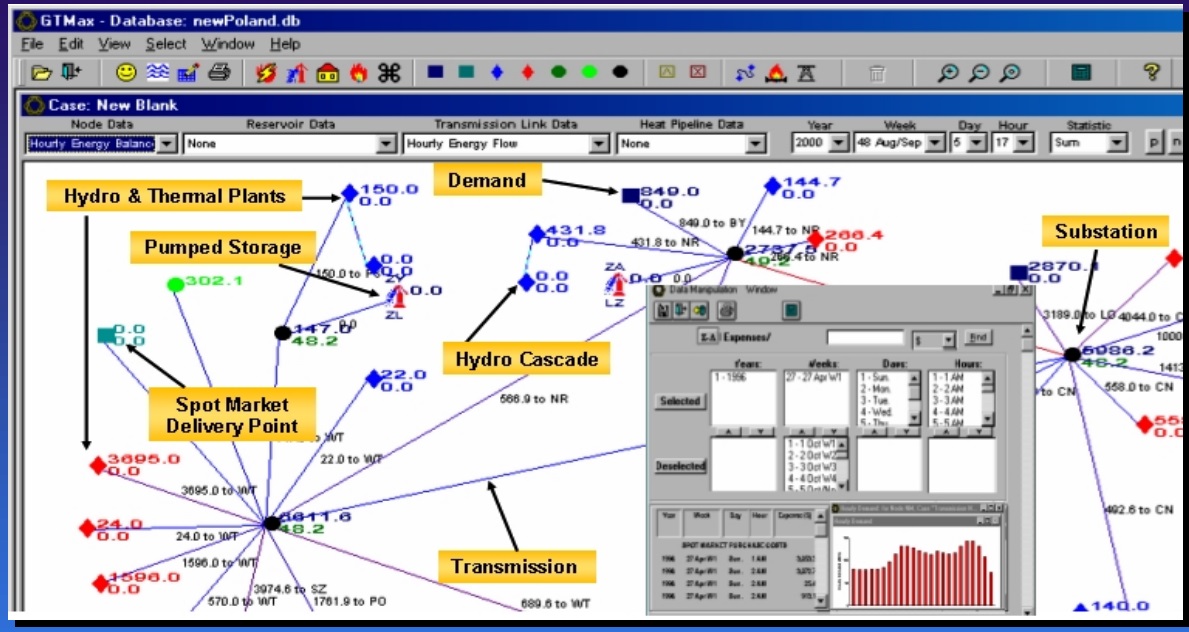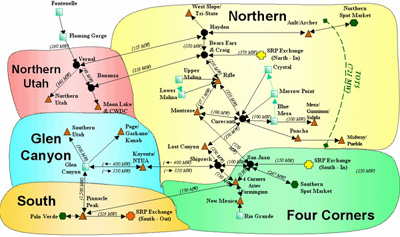Difference between revisions of "GCDAMP- GTMAX"
Cellsworth (Talk | contribs) |
Cellsworth (Talk | contribs) |
||
| Line 17: | Line 17: | ||
</table> | </table> | ||
| − | [[Image:GTMAX- Screen-PIC.jpg|center| | + | [[Image:GTMAX- Screen-PIC.jpg|center|400px]] <br> |
<!-- | <!-- | ||
| Line 24: | Line 24: | ||
|style="width:60%; font-size:120%;"| | |style="width:60%; font-size:120%;"| | ||
| + | WAPA, USBR, FWS, use GTMax to analyze the economics of hydropower systems in the Western U.S. | ||
*GTMax stands for '''G'''eneration and '''T'''ransmission '''Max'''imization | *GTMax stands for '''G'''eneration and '''T'''ransmission '''Max'''imization | ||
*GTMax: A model used to analyze deregulated power market issues | *GTMax: A model used to analyze deregulated power market issues | ||
| − | |||
| − | |||
|}<!-- | |}<!-- | ||
| Line 41: | Line 40: | ||
|class="MainPageBG" style="width:55%; border:1px solid #cef2e0; background:#f5faff; vertical-align:top; color:#000;"| | |class="MainPageBG" style="width:55%; border:1px solid #cef2e0; background:#f5faff; vertical-align:top; color:#000;"| | ||
{|width="100%" cellpadding="2" cellspacing="5" style="vertical-align:top; background:#f5faff;" | {|width="100%" cellpadding="2" cellspacing="5" style="vertical-align:top; background:#f5faff;" | ||
| − | ! <h2 style="margin:0; background:#cedff2; font-size:120%; font-weight:bold; border:1px solid #a3bfb1; text-align:left; color:#000; padding:0.2em 0.4em;">'''Generation and Transmission Maximization (GTMax) Model'''</h2> | + | ! <h2 style="margin:0; background:#cedff2; font-size:120%; font-weight:bold; border:1px solid #a3bfb1; text-align:left; color:#000; padding:0.2em 0.4em;">'''Generation and Transmission Maximization (GTMax) Model [https://ceeesa.es.anl.gov/projects/Gtmax.html]'''</h2> |
|- | |- | ||
|style="color:#000;"| | |style="color:#000;"| | ||
| Line 53: | Line 52: | ||
The GTMax model helps researchers study complex marketing and system operational issues. With the aid of this comprehensive model, utility operators and managers can maximize the value of the electric system, taking into account not only its limited energy and transmission resources, but also firm contracts, independent power producer (IPP) agreements, and bulk power transaction opportunities on the spot market. GTMax maximizes net revenues of power systems by finding a solution that increases income while keeping expenses at a minimum. At the same time, the model ensures that market transactions and system operations remain within the physical and institutional limitations of the power system. When multiple systems are simulated, GTMax identifies utilities that can successfully compete in the market by tracking hourly energy transactions, costs, and revenues. | The GTMax model helps researchers study complex marketing and system operational issues. With the aid of this comprehensive model, utility operators and managers can maximize the value of the electric system, taking into account not only its limited energy and transmission resources, but also firm contracts, independent power producer (IPP) agreements, and bulk power transaction opportunities on the spot market. GTMax maximizes net revenues of power systems by finding a solution that increases income while keeping expenses at a minimum. At the same time, the model ensures that market transactions and system operations remain within the physical and institutional limitations of the power system. When multiple systems are simulated, GTMax identifies utilities that can successfully compete in the market by tracking hourly energy transactions, costs, and revenues. | ||
| − | + | [[Image:Ceeesa ModelsGtmaxRegions.jpg|center|400px]] <br> | |
| − | + | An added benefit of GTMax is that it simulates some limitations, including power plant seasonal capabilities, limited energy constraints, transmission capabilities, and terms specified in firm and IPP contracts. Moreover, GTMax also considers detailed operational limitations, such as power plant ramp rates and hydropower reservoir constraints. Currently, power companies are using GTMax to determine hourly, weekly, and seasonal power and energy offers to customers and to compute the costs of environmental legislation. GTMax can also be used to fine-tune hourly resource generation patterns, spot market transactions, energy interchanges, and power wheeling on the transmission system. | |
An added value of the GTMax model is that it produces financial reports, which help dispatchers identify operational strategies to optimize the value of the system's resources, while continuing to take full advantage of market opportunities. The model also allows to define regions for added reporting capabilities as shown in the figure above. Data from GTMax are presented in easy-to-understand tables and graphs, providing information such as which units should be dispatched, how much power should be generated and sold on an hourly basis, when to buy and sell power on the spot market, the cost of alternative power plant operations, the incremental value of water, and the value of demand-side management programs. | An added value of the GTMax model is that it produces financial reports, which help dispatchers identify operational strategies to optimize the value of the system's resources, while continuing to take full advantage of market opportunities. The model also allows to define regions for added reporting capabilities as shown in the figure above. Data from GTMax are presented in easy-to-understand tables and graphs, providing information such as which units should be dispatched, how much power should be generated and sold on an hourly basis, when to buy and sell power on the spot market, the cost of alternative power plant operations, the incremental value of water, and the value of demand-side management programs. | ||
Revision as of 14:34, 23 August 2024
|
|
WAPA, USBR, FWS, use GTMax to analyze the economics of hydropower systems in the Western U.S.
|
| -- |
-- |
-- |
|---|
|
|

